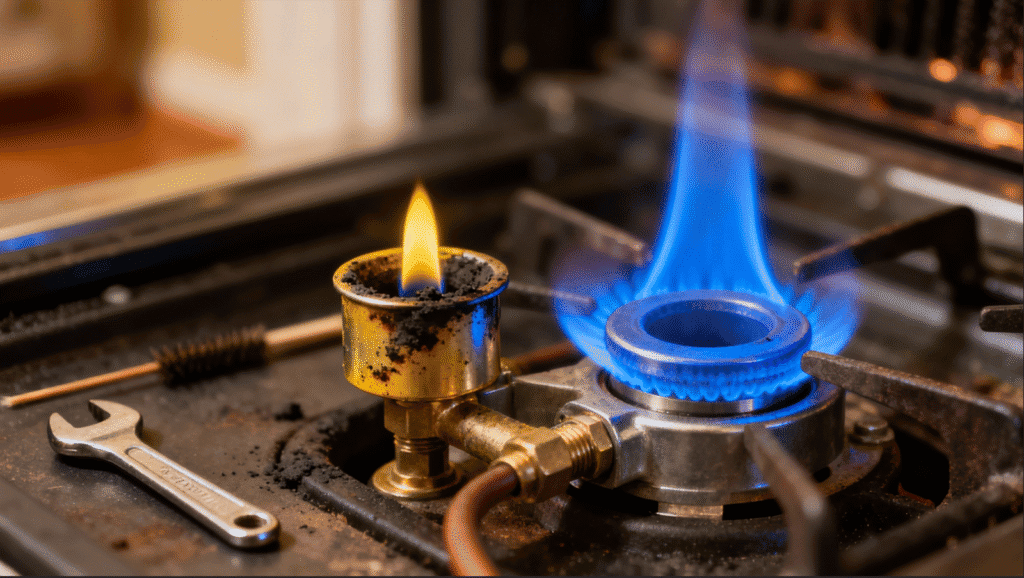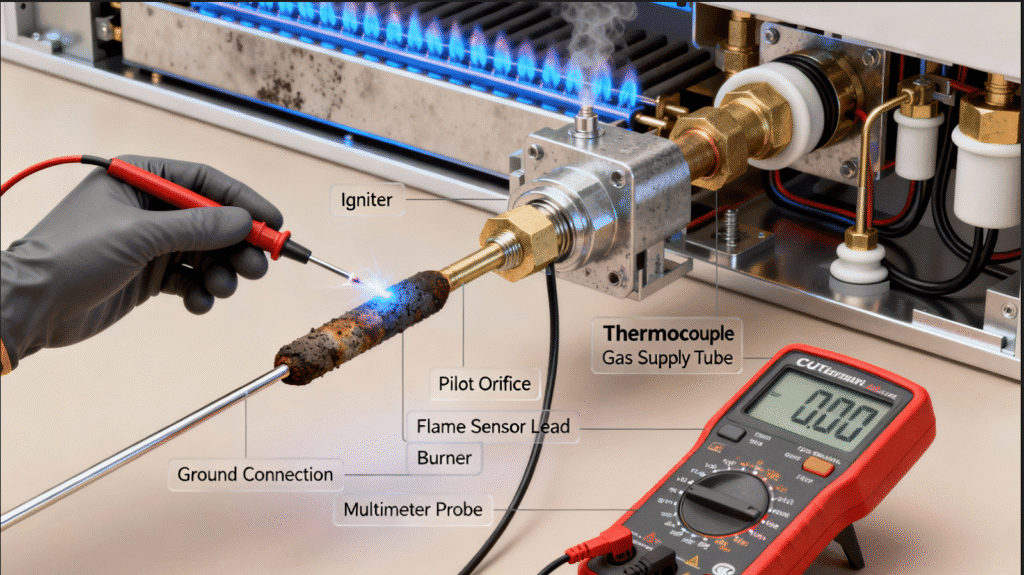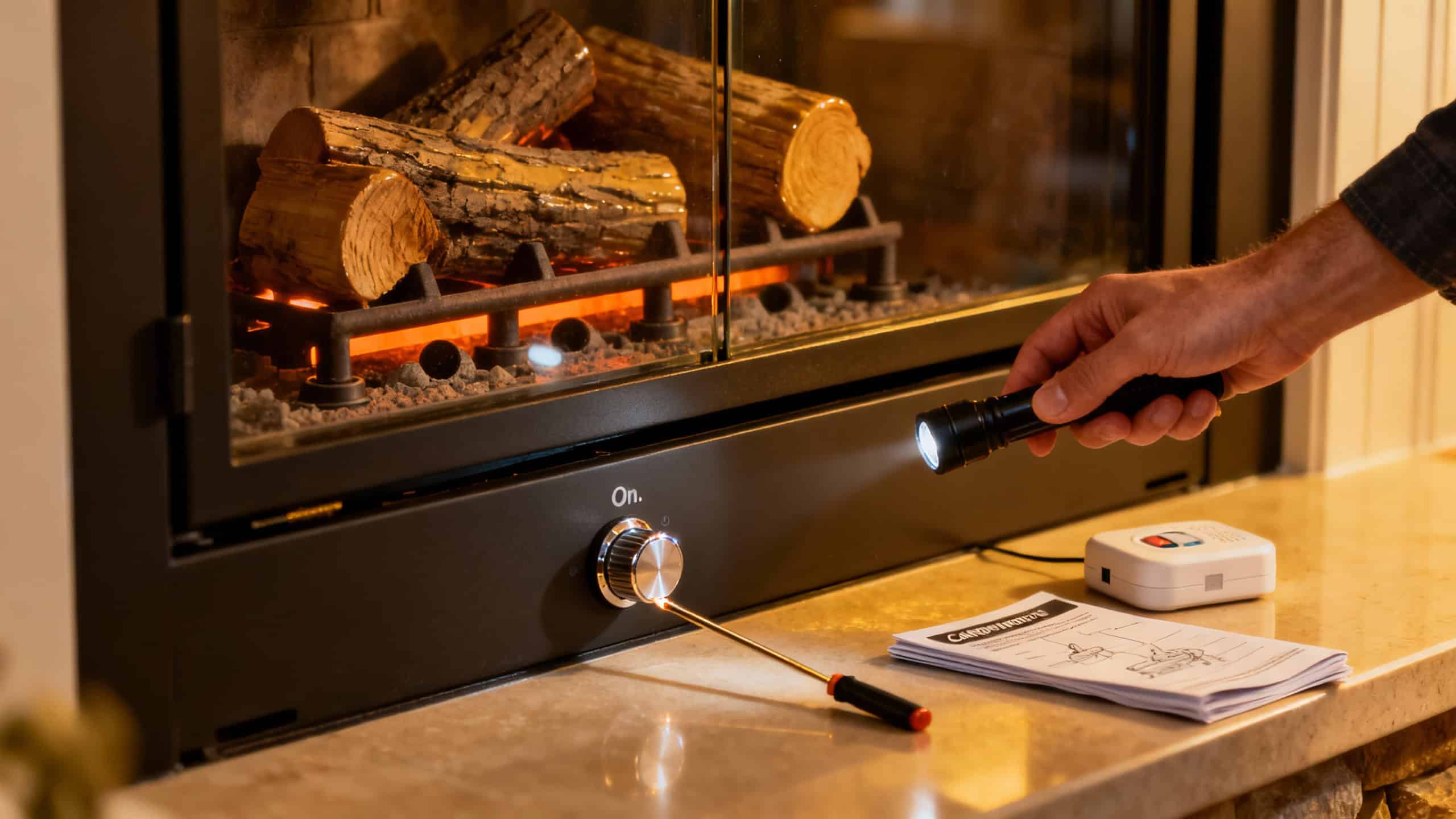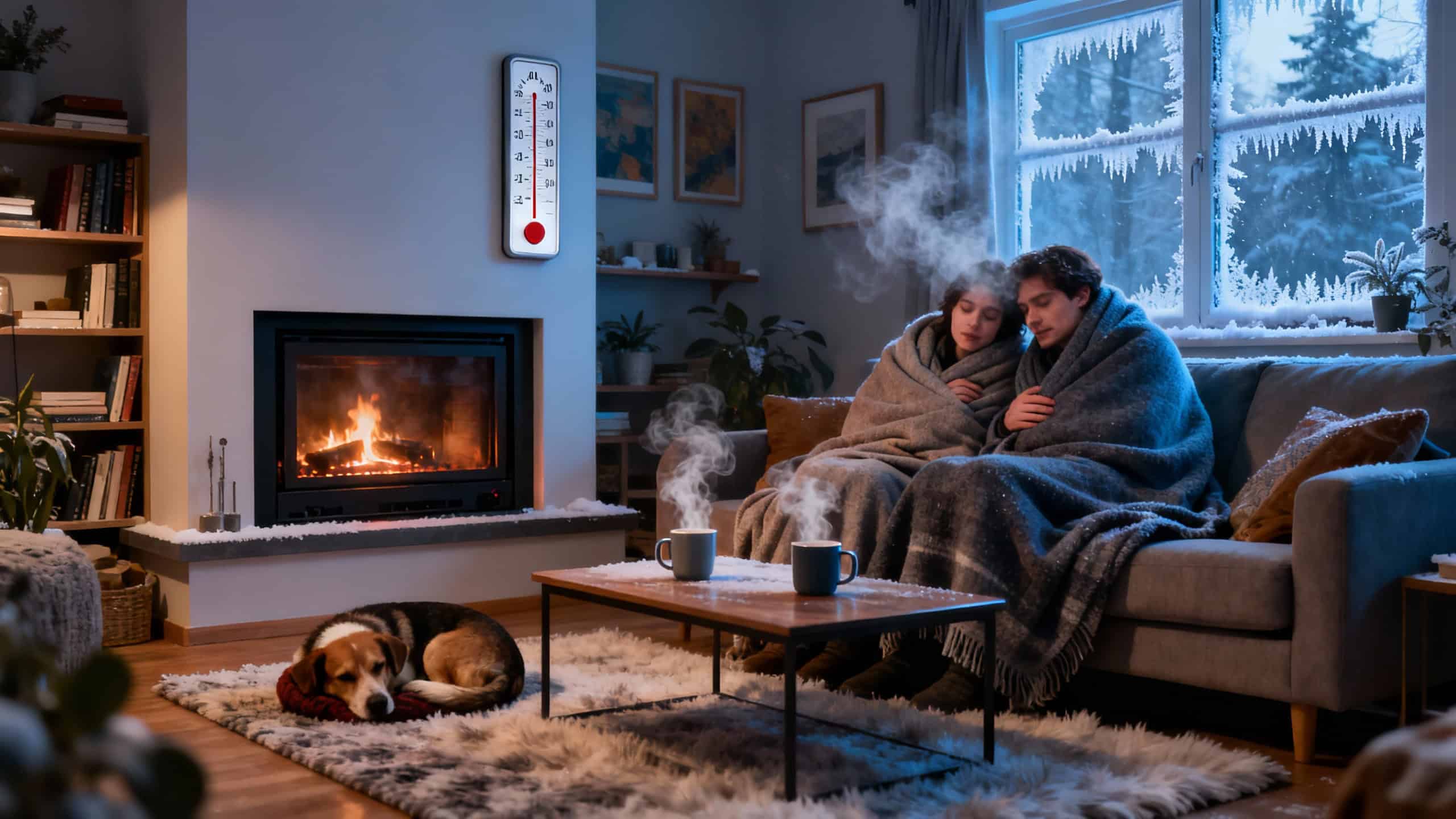A gas fireplace that refuses to ignite usually stems from a faulty thermocouple, dirty pilot assembly, or inadequate gas pressure between 5-7 inches of water column. Homeowners can check if the main shutoff valve runs parallel to the pipe, clean soot-blocked burner ports, or reposition a misaligned thermocouple.
However, persistent problems like continuous clicking, gas odours, or yellow pilot flames require professional diagnosis costing $100-$200 annually. Understanding these common issues and their solutions helps restore reliable flame operation while preventing costly repairs down the line.
Core ideas
- Check if the pilot light is lit; relight it following manufacturer instructions if out or appears weak and yellow.
- Inspect and replace the thermocouple if it’s faulty, as they typically need replacement every 3-5 years.
- Ensure the gas supply valve is fully open, positioned parallel to the pipe, with proper pressure of 5-7 inches.
- Clean burner ports and orifices to remove dust, soot, and carbon buildup that can block gas flow.
- If gas odours occur or issues persist, immediately shut off the gas and contact a licensed professional for safety.
What’s Stopping Your Gas Fireplace from Igniting?
A gas fireplace that refuses to ignite usually suffers from one of five common problems that homeowners can identify with basic troubleshooting.
The pilot light may be out or weak, the igniter or thermocouple could be damaged, or the gas supply might be restricted by a closed valve or low pressure.
Additionally, accumulated dust and soot on the burners can prevent proper ignition, while electrical issues like a failed control board can shut down the entire system.
Even when the pilot lights initially, thermocouple faults can cause it to extinguish shortly after, preventing the fireplace from maintaining a flame.
Pilot Light Problems You Can’t Ignore

When pilot light issues plague gas fireplaces, homeowners often face recurring ignition failures that seem impossible to resolve without professional intervention.
The pilot light serves as the ignition source for the main burner, and when it malfunctions, the entire system fails to operate. A pilot that won’t stay lit typically indicates a faulty thermocouple, which costs $20-$150 to replace, depending on the model.
Weak yellow flames instead of strong blue ones signal incomplete combustion from clogged pilot orifices requiring cleaning.
Draft problems from improperly sealed vents extinguish pilots repeatedly, necessitating damper adjustments or cap repairs ranging from $75-$300.
Gas pressure irregularities below the required 3.5 inches of water column prevent reliable ignition.
These gas fireplace pilot light issues demand systematic diagnosis to restore proper function and prevent gas fireplace not igniting problems.
When the Igniter or Thermocouple Fails to Spark

Gas fireplace ignition systems rely on two critical components that frequently malfunction: the electronic igniter that creates the spark and the thermocouple that monitors flame presence, and when either component fails, homeowners experience complete ignition failure despite proper gas flow.
The igniter typically costs $50-$150 to replace and produces a visible spark when functioning correctly. Testing involves pressing the ignition button while watching for the characteristic clicking sound and blue-white spark near the pilot assembly.
If you ever suspect a gas fireplace gas leak, act immediately, turn off the gas, avoid using electrical switches, and leave the area.
Gas leaks can come from faulty seals or fittings, and only licensed professionals should perform repairs or testing.
Thermocouples, conversely, sense pilot flame heat and signal the gas valve to remain open, preventing gas from flowing when no flame exists.
These sensors accumulate carbon deposits and corrode over time, causing gas fireplace ignition problems that require replacement every 3-5 years.
The pilot light is a small but essential flame that ignites the main burner when your fireplace turns on.
Modern gas fireplaces often feature electronic ignition systems that eliminate the need for a continuously burning pilot, improving both safety and energy efficiency.
Low Gas Pressure or Closed Valves Stopping the Flame
Even with a working igniter and healthy thermocouple, fireplaces sometimes refuse to light when insufficient gas reaches the burner assembly.
Low gas pressure prevents proper combustion, while closed valves block fuel delivery entirely.
If your gas fireplace won’t light despite checking other components, examine the pressure regulator and all valves along the supply line.
The main shutoff valve should be parallel to the pipe, indicating the open position. Additionally, check your home’s gas meter to confirm adequate supply pressure, which typically ranges between 5-7 inches of water column for residential systems.
| Component | Proper Setting |
|---|---|
| Main gas valve | Parallel to the pipe (open) |
| Pressure regulator | 5-7 inches water column |
| Fireplace control valve | Fully counterclockwise |
For persistent issues requiring gas fireplace repair, Toronto homeowners trust licensed technicians to safely diagnose pressure problems.
Dust, Soot, and Dirty Burners That Block Ignition
Accumulated debris inside a gas fireplace creates one of the most common ignition obstacles homeowners encounter. Dust settles on burner ports and blocks gas flow, while soot from previous fires coats the pilot assembly and thermocouple. These layers prevent proper combustion and sensor function.
Inspect the burner area using a flashlight to identify buildup around small gas outlet holes. Use a soft brush or compressed air to remove loose particles from accessible components. For deeper cleaning, gently vacuum around the pilot assembly and burner surface.
If your gas fireplace is not lighting properly and persists after basic cleaning, contact gas fireplace service professionals to disassemble and thoroughly clean internal components. Regular annual maintenance prevents debris accumulation and promotes reliable ignition throughout the heating season.
Power or Control Board Failures That Leave You in the Cold
Modern gas fireplaces rely on electronic control systems to manage ignition sequences, and these sophisticated components can fail without warning.
When a gas fireplace won’t start despite a functioning pilot light and adequate gas supply, the control board or electrical connections may be responsible. These circuit boards typically cost between $150 and $400 to replace, depending on the fireplace model.
Check that the wall switch or remote control has fresh batteries and is properly connected to the unit. Loose wiring connections can prevent the ignition signal from reaching the burner assembly.
Voltage fluctuations or power surges sometimes damage sensitive electronic components permanently. If the receiver module fails to respond to the remote or thermostat commands, the control board likely needs replacement by a qualified technician who can diagnose electrical issues safely.
Quick Fixes You Can Try Before Calling a Pro
Before calling in a professional, homeowners can perform several straightforward checks that often resolve ignition problems in minutes.
These simple troubleshooting steps address the most common causes of gas fireplace ignition failures, from power supply issues to obstructed components.
Testing the gas flow, verifying electrical connections, and cleaning visible parts can save both time and money while restoring reliable fireplace operation.
However, if these basic checks don’t restore function, certified gas fireplace repair services can provide same-day fixes for more complex ignition, pilot, and gas flow issues.
Check the Gas Flow and Pilot Visibility
Sometimes gas flow issues prevent ignition even when other components appear functional.
Start by locating the gas control valve near your fireplace unit and confirm it’s turned fully to the “on” position. A partially open valve restricts gas flow and prevents proper ignition.
Next, examine the pilot light’s visibility through the viewing window or access panel. If the flame appears weak, yellow, or difficult to see, debris may be blocking the pilot orifice. Use a can of compressed air to gently clear any dust or cobwebs around the pilot assembly.
Additionally, verify that your home’s main gas supply hasn’t been interrupted by checking other gas appliances like your stove or water heater.
These simple checks often resolve ignition problems without requiring professional service.
Make Sure Your Remote or Wall Switch Has Power
Many gas fireplaces operate through remote controls or wall-mounted switches, and power issues with these components frequently prevent ignition.
Start by replacing the batteries in your remote control, as weak batteries often fail to send adequate signals to the receiver unit.
Check that wall switches remain securely connected and that circuit breakers haven’t tripped in your electrical panel.
Test the receiver module located inside the fireplace compartment, ensuring all wire connections appear tight and corrosion-free.
Some systems feature indicator lights that confirm power status—consult your owner’s manual to interpret these signals correctly.
If cleaning the burners and checking the gas flow doesn’t restore ignition, it’s time to call a professional. Certified experts in gas fireplace repair can diagnose ignition, pilot, or valve issues safely and restore reliable operation.
Clean Glass and Burners for a Stronger Flame
A dirty glass door and clogged burner ports rank among the most overlooked causes of weak flames and ignition failures in gas fireplaces.
Soot buildup on the glass blocks heat radiation and creates a visual barrier that makes flames appear dimmer than they actually are.
Meanwhile, dust and debris accumulate in the burner ports over time, restricting gas flow and preventing proper ignition.
Clean the glass using a specialized fireplace glass cleaner or a mixture of vinegar and water, wiping in circular motions until clear.
For the burners, turn off the gas supply completely and use a soft brush or compressed air to clear each port opening.
This simple maintenance typically restores full flame strength and guarantees reliable ignition every time.
When It’s Time to Call a Fireplace Technician
While some fireplace issues can be fixed with basic troubleshooting, certain problems require professional attention to guarantee safety and proper repairs.
If the pilot light repeatedly goes out after multiple relighting attempts, or if you smell gas or hear continuous clicking sounds, these are clear signals to stop using the fireplace immediately.
Additionally, when the fireplace ignites normally but shuts off within seconds or minutes, an underlying mechanical or sensor issue likely needs expert diagnosis and repair.
Never attempt to repair faulty gas connections yourself, as damaged seals or fittings require proper shutoff procedures and certified technician expertise to prevent dangerous leaks.
If the Pilot Light Keeps Going Out
Why does the pilot light repeatedly extinguish itself even after multiple relighting attempts? This persistent problem typically points to underlying mechanical issues requiring professional attention.
A faulty thermocouple often fails to detect the pilot flame properly, causing the gas valve to shut off prematurely. Likewise, a damaged thermopile can prevent sufficient voltage from reaching the gas valve to keep it open.
Common causes of recurring pilot light failure include:
- Thermocouple misalignment or deterioration is preventing accurate flame detection
- Inadequate gas pressure from supply line restrictions or regulator malfunctions
- Excessive drafts from chimney problems or improper venting
When relighting attempts prove unsuccessful, contact a TSSA-licensed technician to diagnose the issue.
They possess specialized tools to measure gas pressure, test electrical components, and identify ventilation problems that homeowners cannot safely address themselves.
If You Smell Gas or Hear Continuous Clicking
Beyond pilot light troubles, certain warning signs demand immediate attention and professional intervention rather than DIY troubleshooting.
If you smell the distinctive rotten egg odour of natural gas near your fireplace, immediately turn off the gas supply at the main valve and evacuate your home. Contact your gas company’s emergency line and a licensed HVAC technician before returning.
Continuous clicking sounds when attempting ignition typically indicate a faulty igniter or control module requiring professional replacement. These components involve intricate electrical connections that demand specialized knowledge and tools.
A persistent hissing noise near gas connections suggests a dangerous leak that only certified technicians should address.
TSSA-licensed professionals possess the expertise and equipment to diagnose these serious issues safely, preventing potential carbon monoxide exposure or fire hazards.
If you ever suspect a gas fireplace gas leak, turn off the gas immediately and call a certified technician to prevent hazardous exposure or fire risk.
If the Fireplace Ignites, then it Shuts Off Immediately
A fireplace that lights briefly but shuts off within seconds or minutes indicates a thermocouple malfunction, flame sensor failure, or gas pressure irregularity.
The thermocouple might be positioned too far from the pilot flame, preventing it from heating adequately to keep the gas valve open. Alternatively, a dirty or corroded sensor cannot accurately detect the flame presence, triggering an automatic shutdown as a safety precaution.
Common causes of immediate shutdown include:
- Thermocouple positioning issues where the sensor sits outside the pilot flame’s direct heat zone
- Accumulated debris or corrosion on the flame sensor is preventing proper flame detection
- Insufficient gas pressure caused by regulator problems or supply line restrictions
Cleaning the thermocouple with fine sandpaper and repositioning it closer to the pilot flame often resolves the issue.
However, persistent shutdowns require professional diagnosis to test gas pressure levels and assess component functionality.
How Regular Maintenance Prevents Ignition Trouble
Regular maintenance is the best defence against ignition problems that can leave you in the cold.
Annual professional inspections catch small issues before they turn into expensive emergency repairs, keeping your system running smoothly throughout winter.
Licensed technicians can identify worn thermocouples, dirty pilot assemblies, and gas flow issues during routine checkups, which typically cost $100-$200 but can prevent repair bills of $500 or more.
Understanding the difference between issues you can safely address yourself and problems requiring professional expertise helps you know when to call a technician versus attempting DIY fixes.
Annual Professional Cleaning and Safety Checkups
While homeowners can handle basic cleaning tasks, professional maintenance plays an essential role in preventing ignition problems before they start. TSSA-licensed technicians have specialized tools and training to inspect components that homeowners might miss during routine cleaning.
Annual professional services typically include:
- Complete system inspection, checking the thermocouple, pilot assembly, gas valve, and all electrical connections for wear or damage.
- Deep cleaning of burner ports and logs, removing stubborn carbon deposits that restrict gas flow and prevent proper ignition.
- Safety testing of gas lines using pressure gauges and leak detection equipment to guarantee safe operation throughout the year.
These checkups cost between $150-$250 but prevent costly emergency repairs. Technicians catch small issues early, extending your fireplace’s lifespan and maintaining efficient operation.
Why Licensed Technicians Save You from Costly Repairs
Prevention through professional maintenance delivers financial benefits that far outweigh the upfront service costs. Licensed technicians catch minor issues before they escalate into expensive repairs. A worn thermocouple might cost $150 to replace during routine service, but waiting until it fails could damage the gas valve, turning a simple fix into a $400-$600 repair.
Technicians identify gas leaks, corroded components, and airflow restrictions that homeowners typically miss. These problems compound over time, reducing efficiency and increasing utility bills by 15-25% annually. Regular inspections also extend equipment lifespan by three to five years, delaying the need for full system replacement that can exceed $3,000.
Most importantly, professionals guarantee safe operation, preventing carbon monoxide risks and gas hazards that endanger families and property.
For trusted local expertise and same-day service, homeowners can rely on ALP Heating to keep their fireplaces operating safely and efficiently all season long.
Keeping Your Fireplace Reliable All Winter Long
Most homeowners don’t realize that consistent fireplace maintenance directly prevents the ignition problems covered earlier in this guide.
Annual professional inspections catch small issues before they escalate into complete ignition failure. A qualified technician examines all components—pilot lights, thermocouples, gas valves, and electrical connections—guaranteeing everything operates safely and efficiently.
Regular maintenance delivers concrete benefits:
- Prevents carbon buildup that blocks pilot lights and burner ports, the most common cause of ignition failure
- Extends equipment lifespan by 5-10 years through timely component replacement and adjustments
- Reduces emergency repair costs by identifying worn parts during scheduled visits rather than mid-winter breakdowns
Schedule maintenance appointments in early fall, before heating season begins.
This timing guarantees your fireplace operates reliably when you need it most during the cold winter months.
FAQs About Gas Fireplace Ignition Problems
Gas fireplace owners frequently encounter similar ignition issues and share common questions about troubleshooting their units. Understanding whether a faulty pilot light requires professional repair or simple relighting helps homeowners make informed decisions.
Many wonder how often thermocouples need replacement, with most lasting 3-5 years under normal conditions. Questions about gas valve operation arise frequently, particularly regarding proper positioning and safety protocols.
Homeowners often ask if cleaning can resolve ignition problems before calling technicians. The cost of professional repairs typically ranges from $150-$400, depending on component replacement needs.
Seasonal maintenance questions emerge regularly, with experts recommending annual inspections before winter. Safety concerns about gas leaks and carbon monoxide detection remain top priorities.
Most ignition issues stem from pilot light problems, thermocouple failures, or gas supply interruptions rather than complex mechanical breakdowns. Some owners also experience situations where the fireplace lights initially but then shuts down due to sensor faults, gas flow restrictions, or overheating triggers.
Why does my gas fireplace click but not ignite?
When a gas fireplace produces clicking sounds without igniting, the electronic ignition system is attempting to create a spark but failing to light the gas. This issue typically stems from a few common problems that prevent proper combustion.
Several factors can cause this frustrating situation:
- Dirty or misaligned spark electrode – The electrode may be covered in soot or positioned too far from the burner, preventing the spark from reaching the gas.
- Weak spark from low battery power – Remote controls or wall switches with dying batteries cannot generate sufficient voltage for ignition.
- Blocked gas ports or pilot assembly – Debris accumulation restricts gas flow, leaving nothing for the spark to ignite.
Check these components first before calling for professional service. Most clicking-without-igniting problems resolve with simple cleaning or battery replacement. Similar to ignition issues, dirty burners can also prevent your gas fireplace from producing adequate heat once lit.
Can I safely relight the pilot light myself?
Relighting a pilot light is generally safe for homeowners to perform themselves when following proper procedures and manufacturer guidelines.
Most modern gas fireplaces include clear instructions on the control panel or in the owner’s manual. The process typically involves turning the gas valve to the “pilot” position, pressing and holding the control knob, then using the igniter button to create a spark.
However, certain situations warrant professional assistance. If you smell gas before attempting to relight, evacuate immediately and contact your gas company.
When the pilot light repeatedly extinguishes after relighting, this indicates a deeper mechanical issue requiring expert diagnosis. Additionally, if you feel uncomfortable working with gas appliances or cannot locate the pilot assembly, calling a TSSA-licensed technician guarantees safe resolution.
If your carbon monoxide detector activates during or after relighting attempts, this signals incomplete combustion or ventilation problems that require immediate professional attention.
How often should my gas fireplace be serviced?
Regular maintenance keeps gas fireplaces operating safely and efficiently throughout their lifespan. Experts recommend professional servicing at least once per year, ideally before the heating season begins in early fall.
Annual inspections catch minor issues before they become expensive repairs, ensuring your fireplace ignites reliably when you need it most.
Key maintenance intervals include:
- Annual professional inspection – A certified technician examines all components, cleans the burner assembly, and tests safety controls to prevent ignition failures.
- Monthly visual checks – Homeowners should inspect the pilot light and look for unusual sounds, odours, or visible damage during regular use.
- Bi-annual deep cleaning – Remove accumulated dust and debris from the glass, logs, and interior surfaces every six months to maintain proper airflow.
Consistent servicing extends equipment life and maintains manufacturer warranties on newer installations. During routine inspections, technicians can also identify whether any gas odours indicate normal operation or potentially hazardous leaks requiring immediate attention.








